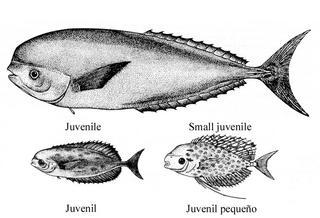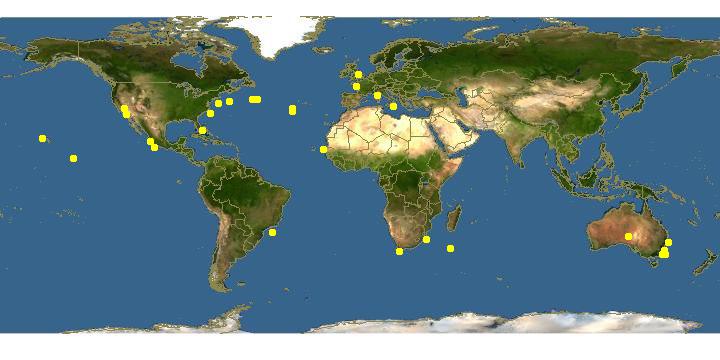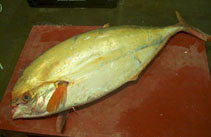
www.fao.org Copyright Michel Lamboeuf · 0
Luvarus imperialis |

Click on map for details about points.
|
| Links |
We parsed the following live from the Web into this page. Such content is managed by its original site and not cached on Discover Life. Please send feedback and corrections directly to the source. See original regarding copyrights and terms of use.
- Australian Faunal Directory
- FishBase
|
|
español |
|
|
Overview | |
Main identification features
Louvar
Head deep, compressed, forehead profile convex; body compressed, tapering to slender caudal peduncle; eyes low, behind small, horizontal mouth; dorsal and anal long, low, similar, origin ~midbody; pelvics tiny, under pectorals; pectoral long, pointed; tail large, semicircular, with 1 large and 2 small keels on base of tail; skin rough, covered with tiny spines; juvenile - dorsal and anal higher, with longer bases, pelvics very long.
Metallic blue to grey above, sides and belly silvery with pink reflections, indistinct dark spots on upper 2/3 body; anal and tail red, pectorals red to yellowish; dorsal red at front black at rear; juveniles with dense large dark spots on body and dorsal and anal fins.
Size: 200 cm.
Habitat: Oceanic; surface to midwater.
Depth: 0-500 m.
Circumglobal, tropical to temperate; throughout our region except the Gulf of California.
Attributes
Abundance: Common.
Cites: Not listed.
Climate Zone: North Temperate (Californian Province &/or Northern Gulf of California); Northern Subtropical (Cortez Province + Sinaloan Gap); Northern Tropical (Mexican Province to Nicaragua + Revillagigedos); Equatorial (Costa Rica to Ecuador + Galapagos, Clipperton, Cocos, Malpelo); South Temperate (Peruvian Province ).
Depth Range Max: 500 m.
Depth Range Min: 0 m.
Diet: pelagic jellyfish/ctenophores; zooplankton.
Eastern Pacific Range: Northern limit=60; Southern limit=-25; Western limit=-124; Eastern limit=-70; Latitudinal range=85; Longitudinal range=54.
Egg Type: Pelagic; Pelagic larva.
Feeding Group: Carnivore.
FishBase Habitat: Pelagic.
Global Endemism: Circumtropical ( Indian + Pacific + Atlantic Oceans); East Pacific + Atlantic (East +/or West); East Pacific + all Atlantic (East+West); All Pacific (West + Central + East); TEP non-endemic; "Transpacific" (East + Central &/or West Pacific); All species.
Habitat: Water column.
Inshore Offshore: Offshore; Offshore Only.
IUCN Red List: Not evaluated / Listed.
Length Max: 200 cm.
Regional Endemism: Island (s); Continent; Continent + Island (s); Tropical Eastern Pacific (TEP) non-endemic; Eastern Pacific non-endemic; All species.
Residency: Resident.
Salinity: Marine; Marine Only.
Water Column Position: Mid Water; Near Surface; Surface; Water column only;
|
|
|
Names | |
|
|
|
Links to other sites | |
|
|
|
References |
- Castro-Aguirre, J.L. and Balart, E.F., 2002., La ictiofauna de las islas Revillagigedos y sus relaciones zoogeograficas, con comentarios acerca de su origen y evolucion. En: Lozano-Vilano, M. L. (Ed.). Libro Jubilar en Honor al Dr. Salvador Contreras Balderas., Universidad Autonoma de Nuevo León:153-170.
- Eschmeyer , W. N. , Herald , E. S. and Hamman, H., 1983., A field guide to Pacific coast fishes of North America from the Gulf of Alaska to Baja California. Peterson Field Guide Ser. 28., Houghton Mifflin:336pp.
- Findley, L.T., Hendrickx, M.E., Brusca, R.C., van der Heiden, A.M., Hastings, P.A., Torre, J., 2003., Diversidad de la Macrofauna Marina del Golfo de California, Mexico., CD-ROM versión 1.0. Projecto de la Macrofauna del Golfo . Derechos reservados de los autores y Conservación Internacional.
- Fischer , W. , Krup , F. , Schneider , W. , Sommer , C. , Carpenter , K. E. and Niem, V. H., 1995., Guia FAO para la Identificacion de Especies de para los fines de la Pesca. Pacifico Centro-Oriental. Volumen III. Vertebrados - Parte 2., FAO3:1201-1813.
- Galván-Magaña, F., Gutiérrez-Sánchez, F., Abitia-Cárdenas, L.A., Rodríguez-Romero, J., 2000., The distribution and affinities of the shore fishes of the Baja California Sur lagoons. In Aquatic Ecosystems of Mexico: Status and Scope. Eds. M. Manuwar, S.G. Lawrence, I.F. Manuwar & D.F. Malley. Ecovision World Monograph Series., Backhuys Publishers:383-398.
- Jimenez-Prado, P., Béarez, P., 2004., Peces marinos del Ecuador continental / Marine fishes of continental Ecuador., SIMBIOE/NAZCA/IFEA tomo 1 y 2.
- Love, M.S., Mecklenburg, C.W., Mecklenburg, T.A., Thorsteinson, L.K., 2005., es of the West Coast and Alaska: a checklist of North Pacific and Artic Ocena species from Baja California to the Alaska-Yukon border., U.S. Department of the Interior, U.S. Geological Survey, Biological Resources Division, 288pp.
- Rafinesque, C. S., 1810., Indice d'ittiologia siciliana; ossia, catalogo metodico dei nomi latini, italiani, e siciliani dei pesci, che si rinvengono in Sicilia disposti secondo un metodo naturale e seguito da un appendice che contiene la descrizione de alcuni nuovi pesci +., Indice Ittiol. Sicil., :1-70.
- Van der Heiden , A. M. and Findley, L. T., 1988., Lista de los peces marinos del sur de Sinaloa, México., Anales del Centro de Ciencias del Mar y Limnologia de la Universidad Autonoma Nacional de Mexico, 15:209-224.
- Walker, B. W. and Baldwin, W. J., 1964., Provisional check list of fishes of the Revillagigedo islands., 18 pp.
|
|
|
Acknowledgements | |
I thank Ashley MacDonald and John Pickering, University of Georgia, for technical support in building this page.
|
|
| Supported by | |
|
Following modified from Australian Faunal Directory
|
Top | See original
| &pull 20q v5.145 20180528: Error 301 Moved Permanently http://biodiversity.org.au/afd/taxa/d93edfab-9592-497a-9b1c-d00c22cb02bf/ |
|
Following modified from FishBase
|
Top | See original
http://www.fishbase.org/Summary/speciesSummary.php?genusname=Luvarus&speciesname=imperialis ---> http://192.134.151.83/Summary/speciesSummary.php?genusname=Luvarus&speciesname=imperialis
http://192.134.151.83/Summary/speciesSummary.php?genusname=Luvarus&speciesname=imperialis ---> https://fishbase.mnhn.fr/Summary/speciesSummary.php?genusname=Luvarus&speciesname=imperialis
https://fishbase.mnhn.fr/Summary/speciesSummary.php?genusname=Luvarus&speciesname=imperialis ---> https://fishbase.mnhn.fr/summary/Luvarus-imperialis.html
Luvarus imperialis, Luvar : fisheries

You can
sponsor
this page
Common name (e.g. trout)
Genus + Species (e.g. Gadus morhua)
-

-
About this page
-
Languages
-
User feedbacks
-
Citation
-
Uploads
-
Related species
-


 Luvar
Add your observation in
Fish Watcher
Upload your
photos
and
videos
Luvar
Add your observation in
Fish Watcher
Upload your
photos
and
videos
Pictures
|
Google image
 Luvarus imperialis
Luvarus imperialis
Picture by
Sacristan, C.
Teleostei (teleosts) >
Acanthuriformes
(Surgeonfishes) >
Luvaridae
(Louvar)
Etymology:
Luvarus:
Sicilian name, luvaru, for a fish (Ref.
45335
)
.
More on author:
Rafinesque
.
Environment: milieu / climate zone / depth range / distribution range
Ecology
Marine; pelagic-oceanic; oceanodromous (Ref.
51243
); depth range 0 - 200 m (Ref.
6517
). Subtropical; 60°N - 25°S, 180°W - 180°E
Atlantic, Indian and Pacific: in temperate and tropical waters (Ref.
47377
). Western Atlantic: USA and eastern Gulf of Mexico (Ref.
7251
). Eastern Atlantic: Bergen, Norway to Madeira and near the Azores, including western Mediterranean; west of Cape Point, South Africa (Ref.
6657
). Western Pacific: Japan, Australia, and New Zealand (Ref.
5755
). Eastern Pacific: Oregon, USA to Chile (Ref.
2850
).
Size / Weight / Age
Maturity: L
m
?
range ? - ? cm
Max length : 200 cm TL male/unsexed; (Ref.
9314
); common length : 152 cm SL male/unsexed; (Ref.
6517
); max. published weight: 150.0 kg (Ref.
47377
)
Dorsal
soft rays
(total): 20;
Anal
spines
: 0;
Anal
soft rays
: 18;
Vertebrae
: 22. Absence of dorsal and anal spines and of pelvic fins contribute to streamlining of the body, as does the flat and relatively consolidated opercular spines (Ref.
11017
, p.
74
).
Oceanic and epipelagic; found near surface or in deep water (Ref.
10821
). Apparently solitary (Ref.
9314
). Feed mainly on jellyfishes, ctenophores, and other gelatinous planktonic animals (Ref.
2850
,
6885
). Spawning starts at the end of spring and during the summer (Ref.
9314
). Juveniles unlike adults in that the median fins are longer and further forward, the mouth toothed and the body and fins black-spotted (Ref.
6517
). Rarely found in markets (Ref.
9314
).
Life cycle and mating behavior
Maturity
|
Reproduction
|
Spawning
|
Eggs
|
Fecundity
|
Larvae
Tyler, J.C., G.D. Johnson, I. Nakamura and B.B. Collette
, 1989. Morphology of
Luvarus imperialis
(Luvaridae), with a phylogenetic analysis of the Acanthuridae (Pisces). Smithsonian Contributions to Zoology, No. 485. Smithsonian Inst. Press, Washington, D.C. 78 p. (Ref.
11017
)
IUCN Red List Status (Ref.
130435
)
Least Concern (LC)
; Date assessed:
13 July 2012
CITES
Not Evaluated
Not Evaluated
Threat to humans
Harmless
Human uses
Fisheries: minor commercial
FAO - Publication:
search
|
FishSource
|
More information
Countries
FAO areas
Ecosystems
Occurrences
Introductions
Stocks
Ecology
Diet
Food items
Food consumption
Ration
Common names
Synonyms
Metabolism
Predators
Ecotoxicology
Reproduction
Maturity
Spawning
Spawning aggregation
Fecundity
Eggs
Egg development
Age/Size
Growth
Length-weight
Length-length
Length-frequencies
Morphometrics
Morphology
Larvae
Larval dynamics
Recruitment
Abundance
BRUVS
References
Aquaculture
Aquaculture profile
Strains
Genetics
Electrophoreses
Heritability
Diseases
Processing
Nutrients
Mass conversion
Collaborators
Pictures
Stamps, Coins Misc.
Sounds
Ciguatera
Speed
Swim. type
Gill area
Otoliths
Brains
Vision
Tools
E-book
|
Field guide
|
Length-frequency wizard
|
Life-history tool
|
Point map
|
Classification Tree
|
Catch-MSY
|
Special reports
Check for Aquarium maintenance
|
Check for Species Fact Sheets
|
Check for Aquaculture Fact Sheets
Download XML
Summary page
|
Point data
|
Common names
|
Photos
Internet sources
AFORO (otoliths) |
Aquatic Commons
|
BHL
|
Cloffa
|
BOLDSystems
|
Websites from users
|
Check FishWatcher
|
CISTI
|
Catalog of Fishes
:
genus
,
species
|
DiscoverLife
|
ECOTOX
| FAO - Publication:
search
|
Faunafri
| Fishipedia |
Fishtrace
| GenBank:
genome
,
nucleotide
|
GloBI
|
Google Books
|
Google Scholar
|
Google
| IGFA World Record |
MitoFish
|
National databases
|
Otolith Atlas of Taiwan Fishes
|
PubMed
| Reef Life Survey | Socotra Atlas |
Tree of Life
| Wikipedia:
Go
,
Search
| World Records Freshwater Fishing |
Zoobank
|
Zoological Record
Estimates based on models
Preferred temperature (Ref.
123201
): 10.1 - 28.2, mean 24.6 °C (based on 1668 cells).
Phylogenetic diversity index (Ref.
82804
): PD
50
= 1.5000 [Uniqueness, from 0.5 = low to 2.0 = high].
Bayesian length-weight: a=0.01122 (0.00514 - 0.02450), b=3.04 (2.87 - 3.21), in cm total length, based on all LWR estimates for this body shape (Ref.
93245
).
Trophic level (Ref.
69278
): 3.8 ±0.46 se; based on food items.
Fishing Vulnerability (Ref.
59153
): Very high vulnerability (90 of 100).
Price category (Ref.
80766
):
Unknown
.
Nutrients (Ref.
124155
): Calcium = 34.8 [20.5, 57.3] mg/100g; Iron = 1.14 [0.70, 1.78] mg/100g; Protein = 19.7 [18.7, 20.6] %; Omega3 = 0.338 [0.212, 0.543] g/100g; Selenium = 37.7 [21.8, 70.6] μg/100g; VitaminA = 6.98 [2.64, 18.68] μg/100g; Zinc = 0.468 [0.336, 0.653] mg/100g (wet weight);
Back to Search
Random Species
Back to Top
Accessed through:
Not available
FishBase mirror site :
localhost
Page last modified by :
mrius-barile
- 20 July 2016
Fatal error
: Uncaught ArgumentCountError: Too few arguments to function checkEcotox(), 1 passed in /var/www/html/summary/speciessummary.php on line 2304 and exactly 3 expected in /var/www/html/includes/speciessummary.lib.php:2579 Stack trace: #0 /var/www/html/summary/speciessummary.php(2304): checkEcotox() #1 {main} thrown in
/var/www/html/includes/speciessummary.lib.php
on line
2579
|
Updated: 2024-05-23 03:05:00 gmt
|